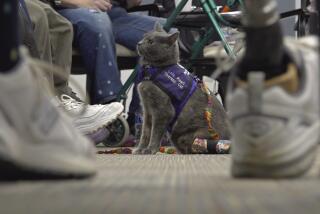Making a Difference: Heads Up Therapy on Horseback : Horsepowered Healing
- Share via
Can a horse help teach a child to walk? For some disabled children at least some of the time, the answer seems to be yes. We’ve had kids end up walking when doctors said they never would, says Nancy Pitchford, founder and executive director of Saugus-based Heads Up Therapy on Horseback, which helps disabled children sharpen their motor skills and build self-confidence. “It can take years,” Pitchford cautions. “It is definitely not pony rides.
Pitchford, a former training specialist at Lockheed, sought accreditation in therapeutic horsemanship in 1985 to share her love of equines. “A horse is nonjudgmental; its rhythmic movement shifts riders in ways similar to walking. The kids learn balance and coordination you can’t create in a clinical setting.”
Pitchford started with her horse and two students. Today there are nine steeds, most of them donated. More than 100 children from the Antelope, Santa Clarita and San Fernando valleys have “graduated,” or met such goals as controlling torso and limbs or improving muscle strength.
When not busy with kids or horse care, Pitchford hits the trail to round up volunteers and additional funds. The nonprofit program’s $80,000 annual budget now comes from donations, fund-raisers and a few grants. “We have a waiting list so the need is there,” she says.
HOW IT WORKS
Participants in the nine-month program have spanned 18 months to 25 years old, with disabilities ranging from autism to spina bifida. Each must have a doctor-approved plan of action, which Pitchford and volunteer Deborah Benz, a physical therapist, consult to customize care. Below is a look at a session with student Daryl Machkowsky.
*
Arrival: Daryl and her father, Mac, leave Van Nuys for the 25-mile trip to Heads Up, which is granted space in the Angeles National Forest under a special agreement with the U.S. Forest Service. “My daughter is 10, but has the mind of an 18-month-old,” says Mac Machkowsky, who is a teacher. “She needs some assistance, but really began walking from the parking lot to the horses.”
*
Saddling Up: After putting on the required helmet, she steps into the arena to greet her horse. The animal wears a soft-pad saddle to allow as much contact as possible. Safety stirrups ensure the child’s leg would not be trapped in case of a mishap. Each of the four riders in the 40-minute session is assisted by a three-person team of volunteers who receive special training from Pitchford.
*
The Arena: To practice balance, the riders hold their arms at shoulder height as the horse is led; guides walk on either side, cheering and clapping encouragement. Next come exercise games such as throwing bean bags into a tire to develop hand-eye coordination. Daryl then works on muscle strengthening by riding standing up on the back of the house, with a guide holding each hand. “I was a very proud papa when she did tricks for the Reagans [as part of a video on therapeutic riding],” her father says.
*
Dismounting: After the lesson, Daryl bids her horse good-bye; children often leave an apple or other treat as thanks. Parents are asked to make a $60-per-month donation toward the care of the animals; scholarships are available. “Daryl started out riding on her tummy six years ago,”says Mac Machkowsky, adding that he and wife Pat “agree it’s a great program.”
AN OBSERVER’S VIEW
“I work with kids who have a lot of problems and frequently recommend them to Heads Up. Kids who’ve not done well in physical therapy make huge strides after being in the program. It’s also very important for their self-esteem to accomplish riding and be able to do something fun that other kids do.”--ROCHELLE FELDMAN, pediatrician, Newhall
To get involved, call (805) 297-7433.
Researched for The Times by PATRICIA A. KONLEY
More to Read
Sign up for The Wild
We’ll help you find the best places to hike, bike and run, as well as the perfect silent spots for meditation and yoga.
You may occasionally receive promotional content from the Los Angeles Times.






